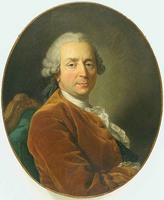
Following a survey ordered in 1738 by the Inspector of Roads, in 1747, a decree issued by the Royal Council, appointed Jean-Rodolphe Perronet as head of the "Draughtsmen’s Office" which notably, had been set up to centralise and conserve the maps and plans of the major roads in the kingdom.
Perronet’s perceived energy for the district of Alençon came to the notice of Trudaine - the overseer of finances in charge of roads - who put him in charge of training surveyors and those drawing maps to provide competent staff for the Ponts et Chaussées - Bridges and Embankments (Civil Engineering Department). He and his work are important because he developed bridge-design in which each arch thrust against its neighbour, enabling spans to be increased, arches flattened, and structures lightened, essentially a principle of Gothic design. His theories influenced, among others, Telford. This training was extended to Civil Engineers and the monitoring of their activities in the districts where they were deployed. Thus began the history of France’s first school of engineering, which, in 1775, was to become the Ecole Royale des Ponts et Chaussées. Perronet busied himself to the organization of the School with great efficiency and devotion throughout his life.
Perronet was an outstanding leader and teacher, and the "spiritual father" of the 350 engineers he trained during the 47 years in which he directed the School. Once they had qualified from the School, Perronet was often responsible for their appointments and then followed their progress and gave them advice throughout their careers. In spite of the reforms of his successors, in particular Lamblardie and Prony, his influence is still felt today.
Perronet’s work as an engineer is just as remarkable and innovative as his work as an administrator. This is witnessed by the twenty or so bridges he designed or built, including those at Mantes, Pont Saint-Maxence, Neuilly, and one in Paris Pont de la Concorde. He designed Pont de Mantes over the Seine (1757–65), Pont de Château-Thierry over the Marne (1765–86), Pont de Neuilly, Paris over the Seine (1768–74), Pont des Fontaines, Chantilly (1770 - 1771), the Pont de Sainte-Maxence, Oise over the Oise (1771–1786) subsequently destroyed, Pont Biais, near Lagny over the Bicheret (1775), the Ponts de Brunoy and de Rozoy over the Yères (1785–1787), and the Pont Louis Seize, now Concorde over the Seine in Paris (1787–1791). He also designed the Canal de Bourgogne (1775–1832).
He constructed more than 2500 km of tree-lined roads when working for the District of Paris, but also worked as a hydraulic engineer on the Canal de l’Yvette; he can be seen as a founding father of Neoclassicism (the 18th century return to classical Greek and Roman design ideas) and was an enthusiastic champion of its contemporary exponents, notably Jacques Germain Soufflot. With his pupil, Émiliand-Marie Gauthey (1732–1808), he sought the best building-stones in France, subjecting them to scientific tests to ensure the Church of Ste-Geneviève would be structurally stable. Perronet is therefore of great importance in the development of structural theory, experiment, and calculations and projects to supply drinking to Paris, the harbours of Cherbourg and Saint Jean de Luz, and the Ports of Le Havre, Dunkerque and Saint Domingo. He also contributed, in an advisory capacity to a multitude of other projects.
Among his distinctions include his appointment as "Chief Engineer" in 1763, and Chief Architect, as well as his membership of the
Academy of Sciences and the Academy of Architecture.
Between 1757 and 1786, he was Inspector General of Salt Flats and then, in 1768, became one of the three directors of the Cassini Map.
In 1763 he was made a knight of the Order of Saint Michel by Louis XV.
His qualities were also recognised in the early days of the revolution, when the Constituent Assembly granted him a pension of £22,600
because of his long and excellent service
.
A friend of Voltaire, Diderot, Buffon and Belidor, he is often referred to as the "Vauban (patriarch ) of Civil Engineering";
it is for this reason that the author believes Perronet to be at the heart of the production management movement.
Perronet passed away on 27 February 1794 in a small house near the Pont Louis XVI (Pont de la Concorde - see below),
the completion of which in 1791 was to be the crowning glory of an outstanding career.

Pont de la Concorde

